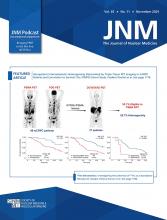TO THE EDITOR: A recent paper by Mosconi et al. (1) reports an in vivo brain 18F-fluoroestradiol (18F-FES) PET study of healthy midlife women, purportedly revealing progressively higher estrogen receptor (ER) density over the menopause transition in estrogen-regulated networks. According to the authors, the latter include “ER-rich” regions such as pituitary, hypothalamus, amygdala, hippocampus, caudate nucleus, thalamus, posterior cingulate cortex, and frontal cortex. The authors further claim that higher ER density in their target regions, which, in addition to the regions mentioned above, also included inferior frontal cortex and middle frontal cortex, was associated with poorer memory performance for the postmenopausal and perimenopausal groups, and predicted the presence of self-reported mood and cognitive symptoms after menopause. We found these results surprising because, although ERs in the brain are believed to mediate estrogen effects on reproductive as well as nonreproductive brain function (2), attempts to measure ERs in the above-mentioned regions (all besides the pituitary and, in one case, hypothalamus) in human (or rodent) brain in vivo have been unsuccessful (3–7).
Review of the literature, including papers cited by the authors, shows that 18F-FES, a tracer useful for breast tumor imaging (8), is not useful for the in vivo detection of ERs in brain tissue. Virtually all attempts to use FES for this purpose in humans and rodents show extensive nonspecific (not displaceable by estradiol and congeners) binding in white matter and no specific (displaceable) uptake in ER-rich regions of the brain. The tracer is only useful in detecting ERs in the pituitary, which lies outside the blood–brain barrier, and in ER-positive breast cancer brain metastases. The authors consistently misquote this literature as it pertains to the actual distribution of ERs in the brain, the utility of FES in measuring brain ERs, and the effects of hormonal status (ovariectomy, estrus cycle) (3–10).
Furthermore, in Figure 1 (1), the authors consistently mislabel white matter brain structures, depicting them as gray matter structures when they are actually white matter. This is apparent in virtually all labeled areas on the sagittal section, which reflect white matter binding. It is particularly obvious in the region labeled “posterior cingulate,” which is clearly the splenium of the corpus callosum. In addition, the coronal images in the figure show that the tracer binds extensively to white matter and not gray matter. The binding that is used as evidence of ER distribution likely reflects partial volume averaging of gray and white matter voxels in the regions of interest. In this regard, Iqbal et al. (7) (ref 25 in the Mosconi paper) showed human brain PET images practically identical to those shown in the paper and identified the high-uptake areas as white matter and pituitary.
The rank order of “ER density” reported in Table 2 (1) bears no relationship to the known distribution of brain ERs (9,10), though it does reflect regional white matter. As acknowledged by the authors, ER density in human and rodent brain follows the rank order of hypothalamus ≥ amygdala ≫ cortex, thalamus, caudate, and cerebellum. However, in Table 2, the hypothalamus has the lowest density (lower than cerebellar gray matter!), the amygdala is the second lowest region, whereas the thalamus and caudate, regions with very low ER density but high white matter content, top the list.
Taken together, these observations indicate the authors were not measuring ER density within the brain but rather nonspecific uptake in white matter, rendering the subsequent analyses and correlations with cognitive performance uninterpretable in the context of ERs. We feel it is important to point out this error so that other scientists do not expend resources pursuing this line of research.
Anat Biegon*, William Jagust, David A. Mankoff
*Stony Brook University School of Medicine Stony Brook, New York
E-mail: anatbiegon{at}gmail.com
- © 2024 by the Society of Nuclear Medicine and Molecular Imaging.
REFERENCES
- Received for publication September 11, 2024.
- Accepted for publication September 18, 2024.







